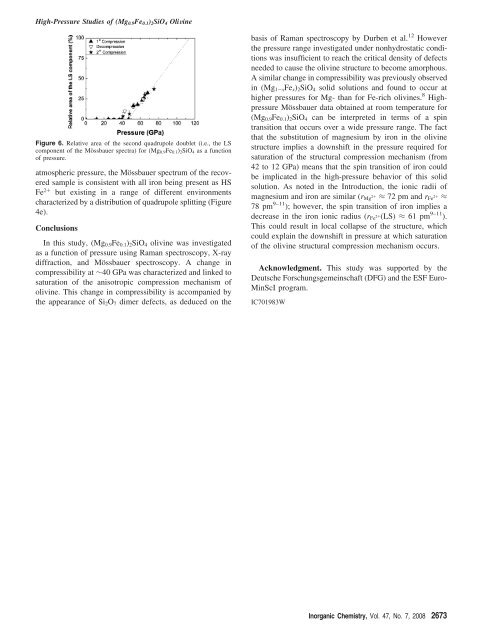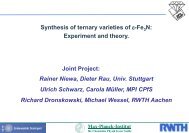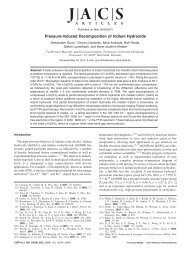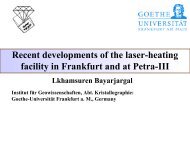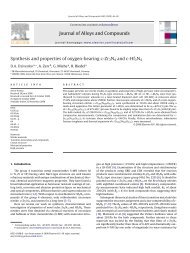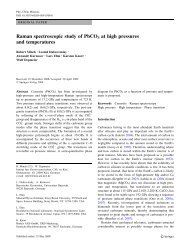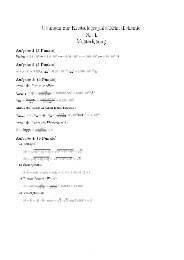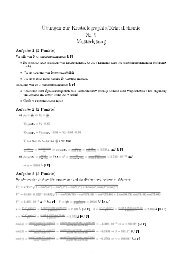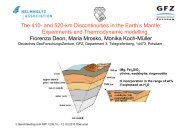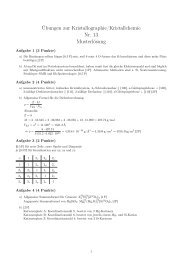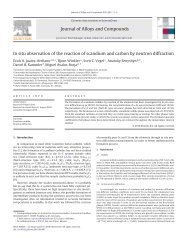High-Pressure Studies of (Mg0.9Fe0.1)2SiO4 Olivine Using Raman ...
High-Pressure Studies of (Mg0.9Fe0.1)2SiO4 Olivine Using Raman ...
High-Pressure Studies of (Mg0.9Fe0.1)2SiO4 Olivine Using Raman ...
Create successful ePaper yourself
Turn your PDF publications into a flip-book with our unique Google optimized e-Paper software.
<strong>High</strong>-<strong>Pressure</strong> <strong>Studies</strong> <strong>of</strong> (<strong>Mg0.9Fe0.1</strong>)<strong>2SiO4</strong> OliWine<br />
Figure 6. Relative area <strong>of</strong> the second quadrupole doublet (i.e., the LS<br />
component <strong>of</strong> the Mössbauer spectra) for (<strong>Mg0.9Fe0.1</strong>)<strong>2SiO4</strong> as a function<br />
<strong>of</strong> pressure.<br />
atmospheric pressure, the Mössbauer spectrum <strong>of</strong> the recovered<br />
sample is consistent with all iron being present as HS<br />
Fe 2+ but existing in a range <strong>of</strong> different environments<br />
characterized by a distribution <strong>of</strong> quadrupole splitting (Figure<br />
4e).<br />
Conclusions<br />
In this study, (<strong>Mg0.9Fe0.1</strong>)<strong>2SiO4</strong> olivine was investigated<br />
as a function <strong>of</strong> pressure using <strong>Raman</strong> spectroscopy, X-ray<br />
diffraction, and Mössbauer spectroscopy. A change in<br />
compressibility at ∼40 GPa was characterized and linked to<br />
saturation <strong>of</strong> the anisotropic compression mechanism <strong>of</strong><br />
olivine. This change in compressibility is accompanied by<br />
the appearance <strong>of</strong> Si2O7 dimer defects, as deduced on the<br />
basis <strong>of</strong> <strong>Raman</strong> spectroscopy by Durben et al. 12 However<br />
the pressure range investigated under nonhydrostatic conditions<br />
was insufficient to reach the critical density <strong>of</strong> defects<br />
needed to cause the olivine structure to become amorphous.<br />
A similar change in compressibility was previously observed<br />
in (Mg1-xFex)<strong>2SiO4</strong> solid solutions and found to occur at<br />
higher pressures for Mg- than for Fe-rich olivines. 8 <strong>High</strong>pressure<br />
Mössbauer data obtained at room temperature for<br />
(<strong>Mg0.9Fe0.1</strong>)<strong>2SiO4</strong> can be interpreted in terms <strong>of</strong> a spin<br />
transition that occurs over a wide pressure range. The fact<br />
that the substitution <strong>of</strong> magnesium by iron in the olivine<br />
structure implies a downshift in the pressure required for<br />
saturation <strong>of</strong> the structural compression mechanism (from<br />
42 to 12 GPa) means that the spin transition <strong>of</strong> iron could<br />
be implicated in the high-pressure behavior <strong>of</strong> this solid<br />
solution. As noted in the Introduction, the ionic radii <strong>of</strong><br />
magnesium and iron are similar (rMg 2+ ≈ 72 pm and rFe 2+ ≈<br />
78 pm 9–11 ); however, the spin transition <strong>of</strong> iron implies a<br />
decrease in the iron ionic radius (rFe 2+(LS) ≈ 61 pm 9–11 ).<br />
This could result in local collapse <strong>of</strong> the structure, which<br />
could explain the downshift in pressure at which saturation<br />
<strong>of</strong> the olivine structural compression mechanism occurs.<br />
Acknowledgment. This study was supported by the<br />
Deutsche Forschungsgemeinschaft (DFG) and the ESF Euro-<br />
MinScI program.<br />
IC701983W<br />
Inorganic Chemistry, Vol. 47, No. 7, 2008 2673


